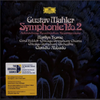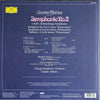



Mahler – Symphony No.2 “Resurrection” - Marilyn Horne, Carol Neblett, Chicago Symphony Chorus, Chicago Symphony Orchestra, Claudio Abbado (2LP)
ORDER LIMITED TO ONE ITEM PER CUSTOMER
Gustav Mahler – Symphony No.2 in C Minor, “Resurrection”
Mezzo-soprano Vocals – Marilyn Horne
Soprano Vocals – Carol Neblett
Chorus – Chicago Symphony Chorus
Chorus Master – Margaret Hillis
Orchestra – Chicago Symphony Orchestra
Conductor – Claudio Abbado
2 LP, Gatefold jacket
Limited to 3,700 numbered copies
Original analog Master tape : YES
Heavy Press : 180g Virgin Vinyl
Record color : black
Speed : 33 RPM
Size : 12'’
Stereo
Studio
Record Press : Optimal Media GmbH in Germany
Label : Deutsche Grammophon - The Original Source series
Original Label : Deutsche Grammophon
Recorded at Medinah Temple, Chicago
Engineered by Heinz Wildhagen
Mixed by Rainer Maillard at Emil Berliner Studios
Produced by Rainer Brock
Mastered by Sidney C. Meyer at Emil Berliner Studios
Lacquers cut by Rainer Maillard at Emil Berliner Studios
Design by Nikolaus Boddin
Photography by Clive Barda, Herbert Tobias
Liner Notes by Richard Osborne
Originally released in 1977
Reissued in June 2025
Tracks:
Side A:
- Ia. Allegro maestoso
- Ib. Sehr mässig und zurückhaltend
- Ic-e. Sehr langsam beginnend - Tempo I - Tempo sostenuto
Side B:
- II. Andante moderato
- III. Scherzo. In ruhig fliessender Bewegung
Side C:
- IV. Urlicht. O Röschen rot
- V. Finale: a. Im Tempo des Scherzos
- V. Finale: b. Langsam
- V. Finale: c. Am Anfang sehr zurückgehalten
- V. Finale: d. Wieder sehr breit
- V. Finale: e. Maestoso. Sehr zurückhaltend
- V. Finale: f. Wieder zurückhaltend
Side D:
- V. Finale: g. Langsam. Immer noch mehr zurückhaltend
- V. Finale: h. Sehr langsam und gedehnt
- V. Finale: i. Langsam. Misterioso Auferstehen, ja auferstehen wirst du gesät
- V. Finale: j. Etwas bewegter. O glaube, mein Herz, o glaube
- V. Finale: k. Wieder etwas zurückhaltend
Review:
“ (…) The engineering here is top-notch, and the Original Source refresh by the wizards of Emil Berliner Studio, Rainer Maillard and Sidney C. Meyer, is as good as any in the series. However, as with a few other releases in this series, there are moments when the very clarity and transparency of mastering directly AAA from the original 4-track masters has revealed some of the shortcomings of the original engineering. And for me those shortcomings relate mainly to the interaction between the performers and the acoustical space in which they have been captured, and how it affects the impact of the music differently in different sections: sometimes very positively (as in the radiant peroration), sometimes a little negatively in the sections that need to present layered differentiation between instruments and sections without losing impact. The large acoustic occasionally mitigates against the achievement of a truly audiophile level of fidelity.
(…) It’s a work that is almost impossible to accommodate within a home audio setting, but this release gets as close as any, and in more than a few places approaches musical and sonic nirvana - just the way Mahler would have wanted it. More please!” Tracking Angle Review by Mark Ward
Ratings :
Discogs : 4.48 / 5 ; Tracking Angle : Music 9 / 11 , Sound 9 / 11




